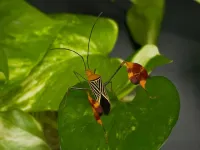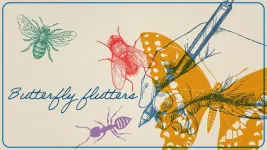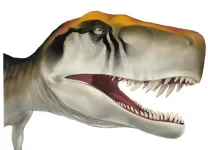(Press-News.org) A University of Texas at Arlington chemist has been honored for his significant contributions to separation science.
Kevin Schug, the Shimadzu Distinguished Professor of Analytical Chemistry, was named recipient of the 2024 Silver Jubilee Medal by the Chromatography Society, a United Kingdom-based organization with worldwide membership. The Silver Jubilee Medal recognizes up-and-coming researchers who have made major use of separation science in their own field or those who have made important contributions to a particular area of separation science. The award was created in 1982 to celebrate the society’s 25th anniversary.
“I know many prominent separation scientists who have been recognized by this medal in the past. I am humbled and honored to be among them,” Schug said. “I understand that I was selected due to my wide range of use and promotion of gas and liquid separations. I credit a lot of current and past students for their contributions to that effort. I must also acknowledge the critical role that industrial partnerships have played.”
Rasika Dias, professor and chair of the UTA Department of Chemistry and Biochemistry, said Schug is deserving of the accolade.
“In a relatively brief period of time, he has established himself as one of the top separation scientists in the world,” he said.
One area of Schug’s research noted by the society is his work with vacuum ultraviolet (VUV) detection for gas chromatography. The VUV detector is made by a Texas company, VUV Analytics Inc.
“VUV Analytics approached me in 2009 to help evaluate and demonstrate the potential of their technology,” Schug said. “This company has since grown, and the technology has been adapted by many companies, particularly in the petrochemical and pharmaceutical spaces.”
The Chromatography Society noted that Schug’s research is primarily applied to the investigation of water treatment analyses and natural products, but also extends to sustainable and environmental trace analyses. It also remarked on his extensive industrial collaborations and his role as founder of the Shimadzu Center for Advanced Analytical Chemistry at UTA.
Schug has been honored with numerous awards, including a Fulbright Distinguished Scholar Award in 2023; the Calvin Giddings Award for Excellence in Education from the American Chemical Society (ACS) Division of Analytical Chemistry in 2017; Tech Titans Future University Award in 2016; Young Investigator in Separation Science Award, ACS Division of Analytical Chemistry, in 2013; CAREER Award by the National Science Foundation in 2009; and the Young Investigator Award in Analytical Chemistry, Eli Lilly and Company, in 2009.
He has also been named three times to the Top 100 Power List by The Analytical Scientist (2023, 2021, 2019) and to the magazine’s Top 40 Under 40 Power List in 2014. He received the UT System Regent’s Outstanding Teaching Award in 2014 and the UTA College of Science Research Excellence Award in 2010. He was named to the UTA Academy of Distinguished Teachers in 2018.
END
UTA chemist acclaimed as up-and-coming scientist
Schug wins Chromatography Society 2024 Silver Jubilee Medal
2024-04-03
ELSE PRESS RELEASES FROM THIS DATE:
'Smart swarms' of tiny robots inspired by natural herd mentality
2024-04-03
In natural ecosystems, the herd mentality plays a major role – from schools of fish, to beehives to ant colonies. This collective behavior allows the whole to exceed the sum of its parts and better respond to threats and challenges.
This behavior inspired researchers from The University of Texas at Austin, and for more than a year they've been working on creating "smart swarms" of microscopic robots. The researchers engineered social interactions among these tiny machines so that they can act as one coordinated group, performing tasks better than they would if they were moving as individuals ...
Earlier menopause plus high cardiovascular risk may lead to cognitive problems later
2024-04-03
MINNEAPOLIS – Earlier menopause combined with higher risk of cardiovascular disease is linked to an increased risk of thinking and memory problems later, according to a new study published in the April 3, 2024, online issue of Neurology®, the medical journal of the American Academy of Neurology. In this study, earlier menopause is defined as occurring before age 49.
As a person ages, blood vessels, including those in the brain, can be damaged by controllable cardiovascular risk factors such as high blood pressure, diabetes and smoking. These risk factors not only increase a person’s risk of cardiovascular disease, ...
Red flags: I’m not the bug for you!
2024-04-03
In the quaint town of Gamboa, nestled near the Panama Canal, a team of scientists embarked on a unique endeavor: attaching red flags onto the legs of crickets and observing how birds respond to them. These eye-catching flags were borrowed from the matador bug (Anisoscelis alipes), an insect renowned for the colorful adornments on its hind legs. This trait has captivated Smithsonian postdoctoral fellow Ummat Somjee for several years, particularly given the matador bug’s tendency to wave them. The persisting question: Why does it wave its colorful hind legs?
A previous study, also supervised by Dr. Somjee, suggested ...
Developing a vaccine for the “zombie drug” xylazine
2024-04-03
LA JOLLA, CA—Xylazine is an FDA-approved sedative and pain reliever for use in animals, but it has severe adverse effects when used in humans. It is now illicitly being added to opioids, like fentanyl and heroin, as well as cocaine—leading to a sharp rise in overdose deaths.
Now, Scripps Research chemical biologists have developed a vaccine to block the effects of xylazine’s toxicity. The vaccine works by training the immune system to attack the drug, which is described in a new paper published in Chemical Communications on April 1, 2024.
“We demonstrated that a vaccine can reverse the symptoms ...
New sunflower family tree reveals multiple origins of flower symmetry
2024-04-03
UNIVERSITY PARK, Pa. — The sunflower family tree revealed that flower symmetry evolved multiple times independently, a process called convergent evolution, among the members of this large plant family, according to a new analysis. The research team, led by a Penn State biologist, resolved more of the finer branches of the family tree, providing insight into how the sunflower family — which includes asters, daisies and food crops like lettuce and artichoke — evolved.
A paper describing the analysis and findings, which researchers said may help identify useful traits to selectively breed plants with more desirable characteristics, appeared online in the journal ...
Lurie Children’s Hospital first in Illinois to treat Duchenne muscular dystrophy with FDA-approved gene therapy
2024-04-03
On March 27, 2024, Ann & Robert H. Lurie Children’s Hospital of Chicago treated its first patient with ELEVIDYS (delandistrogene moxeparvovec-rokl), the first gene therapy for Duchenne muscular dystrophy – a rare, genetic disease characterized by progressive muscle damage and weakness. Lurie Children’s is the first in Illinois to administer this treatment after ELEVIDYS received U.S. Food and Drug Administration (FDA) approval in June 2023.
Developed by Sarepta Therapeutics, ELEVIDYS is approved for the treatment of Duchenne muscular dystrophy (DMD) in ambulatory patients aged 4 through 5 years with ...
Butterflies, bees, ants and flies are the most widely referenced arthropods in a sample of almost 4,000 haiku - which commonly describe their color, flight and ecology
2024-04-03
Butterflies, bees, ants and flies are the most widely referenced arthropods in a sample of almost 4,000 haiku - which commonly describe their color, flight and ecology
###
Article URL: https://journals.plos.org/plosone/article?id=10.1371/journal.pone.0298865
Article Title: Diversity and complexity of arthropod references in haiku
Author Countries: USA
Funding: The author(s) received no specific funding for this work. END ...
Might your personality affect how you move? Runners classified as Myers-Briggs "Sensing" types have a more grounded running style in experiments than those classified as "Intuition" types
2024-04-03
Might your personality affect how you move? Runners classified as Myers-Briggs "Sensing" types have a more grounded running style in experiments than those classified as "Intuition" types
###
Article URL: https://journals.plos.org/plosone/article?id=10.1371/journal.pone.0300108
Article Title: Mind to move: Differences in running biomechanics between sensing and intuition shod runners
Author Countries: France, Switzerland, Belgium
Funding: The author(s) received no specific funding for this work. END ...
Early dinosaurs grew up fast, but they weren’t the only ones
2024-04-03
The earliest dinosaurs had rapid growth rates, but so did many of the other animals living alongside them, according to a study published April 3, 2024 in the open-access journal PLOS ONE by Kristina Curry Rogers of Macalester College, Minnesota and colleagues.
Dinosaurs grew up fast, a feature that likely set them apart from many other animals in their Mesozoic (252 to 66 million years ago) ecosystems. Some researchers have proposed that these elevated growth rates were key to the global success of dinosaurs, but little is known about the growth strategies of the earliest dinosaurs. In this study, Rogers and colleagues performed histological analysis, examining patterns of bone ...
Working outside the typical 9–5 in younger adulthood may be linked with worse health decades later
2024-04-03
The hours you work earlier in life may be associated with worse health years later, according to a study published April 3, 2024 in the open-access journal PLOS ONE by Wen-Jui Han from New York University, US.
Studies have consistently shown that nonstandard work schedules—working outside the traditional nine-to-five workday—can negatively impact physical and mental health as well as social and family life. The current study uses a life-course approach to provide a longer-term perspective on how work schedule ...
LAST 30 PRESS RELEASES:
COVID-19 leaves a lasting mark on the human brain
Scientists use ultrasound to soften and treat cancer tumors without damaging healthy tissue
Community swimming program for Black youth boosts skills, sense of belonging, study finds
Specific depressive symptoms in midlife linked to increased dementia risk
An ‘illuminating’ design sheds light on cholesterol
Who is more likely to get long COVID?
Study showcases resilience and rapid growth of “living rocks”
Naval Research Lab diver earns Office of Naval Research 2025 Sailor of the Year
New Mayo-led study establishes practical definition for rapidly progressive dementia
Fossil fuel industry’s “climate false solutions” reinforce its power and aggravate environmental injustice
Researchers reveal bias in a widely used measure of algorithm performance
Alcohol causes cancer. A study from IOCB Prague confirms damage to DNA and shows how cells defend against it
Hidden viruses in wastewater treatment may shape public health risks, study finds
Unlock the power of nature: how biomass can transform climate mitigation
Biochar reshapes hidden soil microbes that capture carbon dioxide in farmland
Reducing saturated fat intake shows mortality benefit, but only in high-risk individuals
Manta rays create mobile ecosystems, study finds
Study: Mixed results in using lipoic acid to treat progressive multiple sclerosis
Norbert Holtkamp appointed director of Fermi National Accelerator Laboratory
New agentic AI platform accelerates advanced optics design
Biologists discover neurons use physical signals — not electricity — to stabilize communication
Researchers discover that a hormone can access the brain by hitchhiking
University of Oklahoma researcher awarded funding to pursue AI-powered material design
Exploring how the visual system recovers following injury
Support for parents with infants at pediatric check-ups leads to better reading and math skills in elementary school
Kids’ behavioral health is a growing share of family health costs
Day & night: Cancer disrupts the brain’s natural rhythm
COVID-19 vaccination significantly reduces risk to pregnant women and baby
The role of vaccination in maternal and perinatal outcomes associated with COVID-19 in pregnancy
Mayo Clinic smartwatch system helps parents shorten and defuse children's severe tantrums early
[Press-News.org] UTA chemist acclaimed as up-and-coming scientistSchug wins Chromatography Society 2024 Silver Jubilee Medal







